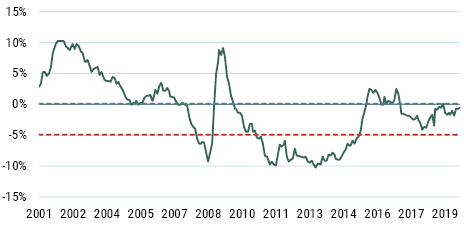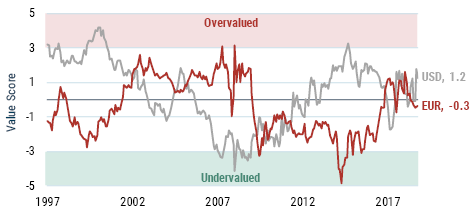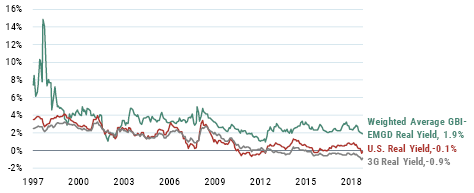Executive Summary
Through the first three quarters of the year, both sovereign external and local currency debt have performed well. The EMBIG index is up 12.1% year-to-date through September 30, while the local debt GBI-EMGD index is up 7.9%.
We find valuations to be reasonably attractive for both asset classes at this stage. According to our valuation metrics, sovereign credit spreads have narrowed in relation to underlying credit quality, but still look moderately generous. Similarly, on the local debt side, emerging currencies remain at the cheap end of our neutral range, with valuations becoming slightly more attractive in the past quarter. Local rates markets, despite a strong rally, continue to look attractive relative to G-3 real yields, which remain at or near their extreme lows.
In this piece, we update our valuation charts and commentary, and provide more detail on the methodology in the accompanying appendix.
External Debt Valuation
Valuations in the external sovereign debt market became slightly less attractive in the third quarter. As seen in Exhibit 1, the current multiple of the benchmark’s credit spread to the spread that would be required to compensate for credit losses fell over the course of the quarter. That multiple stood at 3.2x on September 30, 2019, down from 3.4x on June 28. Based solely on the historical experience, this multiple of 3.2x is still within the range of values that we would consider attractive. As described in more detail in the appendix, a ratio above 3.0 has, over the past 25 years, resulted in positive credit spread returns over the subsequent 24-month period, 90% of the time.
Exhibit 1: Long-Term View of the “Fair Market Multiple” for Emerging External Debt

As of 9/30/19 | Source: GMO calculations based on Bloomberg and J.P. Morgan data
Note: Green line represents a credit multiple level above which EMBIG has subsequently delivered positive credit returns historically; red line represents a credit multiple below which EMBIG has subsequently delivered negative credit returns historically.
The main reason for the decrease in the multiple was a decline in the EMBIG spread, which fell by 28 bps over the quarter, due in part to index compositional changes described below. Comparatively, the “fair value” spread of the EMBIG that would be required to compensate for expected credit losses fell only 3 bps, from 110 bps at the end of June to 107 bps at the end of September. Regular readers will recall that this fair value spread is a function of the weighted-average credit rating of the benchmark, along with data and assumptions on rating transition probabilities and recovery values given default. As mentioned in last quarter’s publication, the phasing in of several GCC countries into the EMBIG benchmark have continued to apply downward pressure on the fair value spread. These countries generally have high credit ratings, and their phased inclusion is increasing the overall credit quality of the underlying benchmark, therefore lowering the theoretical credit spread required to compensate for credit losses. Another factor in favor of a lowering of the fair value spread was Venezuela’s declining weight in the benchmark, which fell from 1.0% to just 0.2% over the course of the quarter. Partially mitigating these effects were rating changes for the countries in the index, which were slightly negatively skewed in the third quarter. Most notably, Argentina was downgraded multiple notches as currency and volatility soared and the government opened conversations on a restructuring of its outstanding obligations. Elsewhere, we saw downgrades for Zambia and Trinidad, and upgrades in Jamaica and Ukraine.
The preceding was a discussion of the level of spreads, or credit cushion. From a total return standpoint, the level and changes of the underlying risk-free rate also matters. In the third quarter, trends in U.S. Treasury yields were once again a major contributor to returns, with the 10-year yield falling another 34 bps. We measure the “cushion” in Treasuries by the slope of the forward curve of the 10-year swap rate, depicted by the light-font lines in Exhibit 2. The interest rate “cushion” (which we proxy as the slope of the forward curve) continues to be low by historical standards, meaning a sharp rise in the 10-year Treasury yield would be a surprise to the market. The slope of the 10-year forward curve ended the quarter at just 8 bps, even lower than the 21 bps of the prior quarter.
Exhibit 2: 10-Year U.S. Treasury Swap Curves at Quarterly Intervals

As of 9/30/19 | Source: GMO
Note: Projections as of each date, including those that are beyond 2015, are future prices as determined by the market and are not a GMO projection.
Local Debt Markets Valuation
Exhibit 3 below provides a snapshot of our new currency valuation methodology that we introduced at the end of Q2 2018. In Q1 2019, we made some enhancements that are reflected in the exhibit (for more information please see the Appendix). The underlying model analyzes trends in macroeconomic fundamentals such as balance of payments composition and flows, valuation of the currency, and the economic cycle, via an econometric analysis, to come up with an estimate of total expected FX returns for each country in the GBI-EMGD benchmark. These are then combined into a single value of a total expected FX return using a weighted average of currencies in the GBI-EMGD. We then deduct the GBI-EMGD weighted carry from the estimated GBI-EMGD weighted value of total FX expected return to get to an expected EM FX spot return. Finally, we estimate a neutral range based on the backtest of the overall model (see the Appendix for more information) to assess whether EM currencies are cheap, rich, or fairly valued. A value that is higher (lower) than the upper (lower) value of the neutral range could potentially indicate “cheap” (“rich”) currencies. A value that is within the neutral range would be considered “fair.” Based on the new methodology, EM currencies, while not outright cheap, are still hovering close to the cheap end of the neutral range and still slightly better than their 5-year average value in terms of fundamental value.
Exhibit 3: GBI-EMGD Expected Spot FX Return Given the Fundamentals

As of 9/30/19 | Source: GMO
Note: The values shown above apply the GBI-EMGD weights to the emerging currencies.
The expectations provided above are based upon the reasonable beliefs of the Emerging Country Debt team and are not a guarantee. Expectations speak only as of the date they are made, and GMO assumes no duty to and does not undertake to update such expectations. Expectations are subject to numerous assumptions, risks, and uncertainties, which change over time. Actual results may differ materially from those anticipated in the expectations above.
Exhibit 4 provides a snapshot of our traditional currency valuation methodology, which combines trends in the balance of payments and the real effective exchange rate, via a z-score analysis, and measures how far away current values are from their long-term averages. We keep our traditional valuation model in order to monitor the valuation of the USD and EUR. According to this methodology, the EUR remains slightly cheap, with little change over the course of the quarter. As for the USD, valuations now look expensive after beginning the quarter in roughly neutral territory. For dollar-based and euro-based investors, investing in local currency emerging fixed income markets remains attractive from an outright valuation perspective, although not as much as at the end of 2018.
Exhibit 4: Value Score USD and EUR

As of 9/30/19 | Source: GMO
Note: The value scores shown above apply the GBI-EMGD weights to the emerging currencies. GMO calculates a currency’s value score using a combination of the currency’s trend real price and the country’s trend current account balance.
As for emerging market local interest rates, we consider differentials in real yields to gauge the relative attractiveness of EM against developed markets (see Exhibit 5 below). In this regard, the story that has been in place for many quarters (years, actually) remains as we can still witness a substantial positive gap between EM and developed market real yields. That gap narrowed moderately during the third quarter as emerging real yields decreased to 1.9% from 2.2% as nominal yields rallied. The spread between EM and U.S. real yields (2.0%) was unchanged during the quarter, in spite of the continued decline in U.S. rates. The spread remains above the historical average (1.6%) and is now at the average spread since 2010 (2.0%), as seen in Exhibit 5. By our calculations, real yields in the G-3 are now all below zero, with the U.S. joining Japan and the Eurozone in negative territory. Real yields in emerging markets are still well below their historical average (2.6%), and in the third quarter dipped below 2.0% for the first time since early 2015.
Exhibit 5: Inflation-Adjusted Bond Yields

As of 9/30/19 | Source: GMO
Note: Real yields are measured using the country subindices of the GBI-EMD and GBI Global, respectively, less Consensus Forecast CPI.
Download to read the full article.

